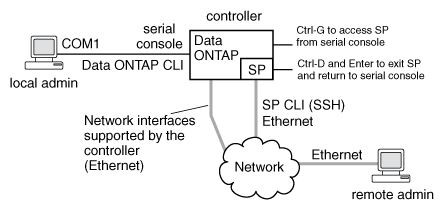Remote node management with the ONTAP Service Processor
 Suggest changes
Suggest changes


The Service Processor (SP) is a remote management device that enables you to access, monitor, and troubleshoot a node remotely.
The key capabilities of the SP include the following:
-
The SP enables you to access a node remotely to diagnose, shut down, power-cycle, or reboot the node, regardless of the state of the node controller.
The SP is powered by a standby voltage, which is available as long as the node has input power from at least one of its power supplies.
You can log in to the SP by using a Secure Shell client application from an administration host. You can then use the SP CLI to monitor and troubleshoot the node remotely. In addition, you can use the SP to access the serial console and run ONTAP commands remotely.
You can access the SP from the serial console or access the serial console from the SP. The SP enables you to open both an SP CLI session and a separate console session simultaneously.
For instance, when a temperature sensor becomes critically high or low, ONTAP triggers the SP to shut down the motherboard gracefully. The serial console becomes unresponsive, but you can still press Ctrl-G on the console to access the SP CLI. You can then use the
system power onorsystem power cyclecommand from the SP to power on or power-cycle the node. -
The SP monitors environmental sensors and logs events to help you take timely and effective service actions.
The SP monitors environmental sensors such as the node temperatures, voltages, currents, and fan speeds. When an environmental sensor has reached an abnormal condition, the SP logs the abnormal readings, notifies ONTAP of the issue, and sends alerts and “down system” notifications as necessary through an AutoSupport message, regardless of whether the node can send AutoSupport messages.
The SP also logs events such as boot progress, Field Replaceable Unit (FRU) changes, events generated by ONTAP, and SP command history. You can manually invoke an AutoSupport message to include the SP log files that are collected from a specified node.
Other than generating these messages on behalf of a node that is down and attaching additional diagnostic information to AutoSupport messages, the SP has no effect on the AutoSupport functionality. The AutoSupport configuration settings and message content behavior are inherited from ONTAP.
The SP does not rely on the
-transportparameter setting of thesystem node autosupport modifycommand to send notifications. The SP only uses the Simple Mail Transport Protocol (SMTP) and requires its host's AutoSupport configuration to include mail host information.If SNMP is enabled, the SP generates SNMP traps to configured trap hosts for all “down system” events.
-
The SP has a nonvolatile memory buffer that stores up to 4,000 events in a system event log (SEL) to help you diagnose issues.
The SEL stores each audit log entry as an audit event. It is stored in onboard flash memory on the SP. The event list from the SEL is automatically sent by the SP to specified recipients through an AutoSupport message.
The SEL contains the following information:
-
Hardware events detected by the SP—for example, sensor status about power supplies, voltage, or other components
-
Errors detected by the SP—for example, a communication error, a fan failure, or a memory or CPU error
-
Critical software events sent to the SP by the node—for example, a panic, a communication failure, a boot failure, or a user-triggered “down system” as a result of issuing the SP
system resetorsystem power cyclecommand
-
-
The SP monitors the serial console regardless of whether administrators are logged in or connected to the console.
When messages are sent to the console, the SP stores them in the console log. The console log persists as long as the SP has power from either of the node power supplies. Because the SP operates with standby power, it remains available even when the node is power-cycled or turned off.
-
Hardware-assisted takeover is available if the SP is configured.
-
The SP API service enables ONTAP to communicate with the SP over the network.
The service enhances ONTAP management of the SP by supporting network-based functionality such as using the network interface for the SP firmware update, enabling a node to access another node's SP functionality or system console, and uploading the SP log from another node.
You can modify the configuration of the SP API service by changing the port the service uses, renewing the SSL and SSH certificates that are used by the service for internal communication, or disabling the service entirely.
The following diagram illustrates access to ONTAP and the SP of a node. The SP interface is accessed through the Ethernet port (indicated by a wrench icon on the rear of the chassis):




